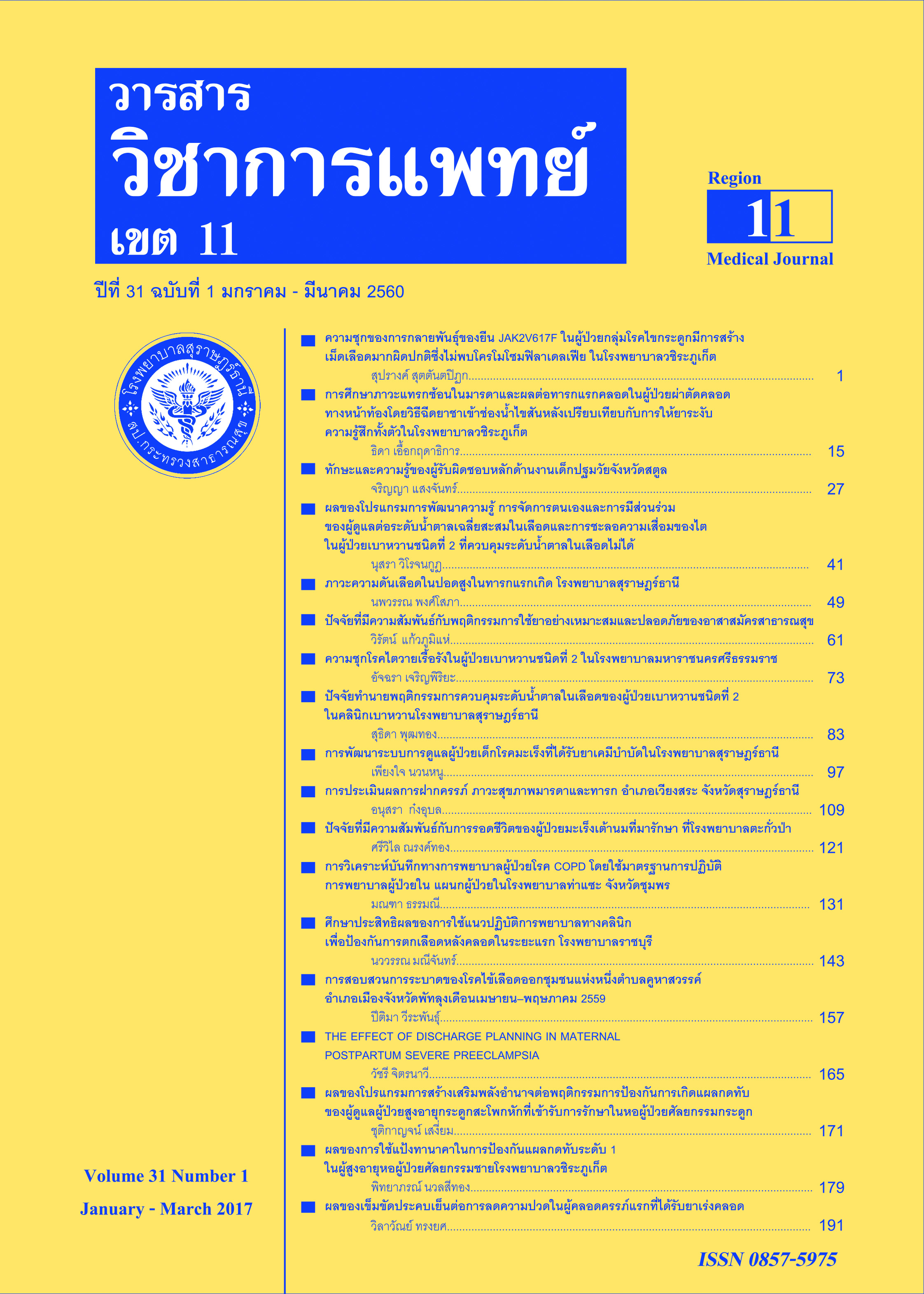The Results of Using Starch Tanaka Powder in Preventing Pressure Injury Stage 1 in the Elderly at Male Surgical Ward at Vachira Phuket Hospital
Keywords:
Tanaka powder, the elderly, pressure injury stage 1Abstract
Pressure injury is the most common complication in elderly patients who are admitted to the hospitals. Usually pressure injury can be prevented. Tanaka powder contains properties to maintain strength and flexibility of skin tissue. Therefore, researchers were interested in using Tanaka powder to examine if it could prevent skin from pressure injury. This research was an experimental research (Quasi-experimental research design) and the data was collected from March to June, 2016. There were 30 patients admitted in the male surgical ward at Vachira Phuket Hospital. The control group consisted of 15 patients receiving standard medical practice activities in order to prevent pressure ulcers, and the experimental group consisted of 15 patients getting
the same standard practice nursing as a control group as well as the use of Tanaka powder. The results show that the tests for discrepancies between variable information which might have effects on the incidence of pressure ulcers such as age, body mass index, temperature and Braden’s by using statistical Mann - Whitney U Test between the control group and the experimental group were not statistically significant different, p ≥ .05. When comparing with clinical outcomes, it was found that pressure ulcers in the control group and the experimental group by using Chi - square statistics show no statistically significant difference p ≥ .05. However, the incidence of pressure ulcers in the control group decreased with four patients whereas there was only one patient in the e xperimental group. By using Tanaka powder in order to preventstage1 of pressure ulcers in the elderly patients, the researchers found that there was a tendency for the decrease of the pressure ulcers. The limitation of this study was the limited number of samples. In the future, there should be a further study in order to use the Tanaka powder more efficiently. For the prevention of pressure injury, there should be a regulation for strictly controlling nursing activities as well.
References
2. ขวัญจิตร ปุ่นโพธ์,จิณพิชญ์ชา มะมม.การศึกษาผลของกระบวนการดูแลแผลในการส่งเสริมการหายของแผลการลดความเสี่ยงในการเกิดแผลใหม่และความพึงพอใจของผู้ป่วยและญาติผู้ป่วยที่มีแผลกดทับ.วิทยานิพนธ์กลุ่มงานการพยาบาล โรงพยาบาลธรรมศาสตร์เฉลิมพระเกียรติ.[ออนไลน์].Available from http://www.hospital.tu.ac.th/PlanTUHosWeb/ data/Project%20Research/research_ 2555/5530016.pdf.[สืบค้นเมื่อ 15 มีนาคม 2559].
3. จิณพิชญ์ชา มะมม. บทบาทพยาบาลกับแผลกดทับ: ความท้าทายในการป้องกันและการดูแล.วารสารวิทยาศาสตร์และเทคโนโลยี;2555:20(5):478-490.
4. ชวลี แย้มวงศ์, จันทร์ทิพย์ วงศ์วิวัฒน์, ปานจิตร โชคพิชิต. การลดอุบัติการณ์การเกิดแผลกดทับ : รูปแบบการดูแลโดยการวิจัยเชิงปฏิบัติการ. วารสารสภาการพยาบาล; 2548:20(1): 33-42.
5. พัทนัย แก้วแพง, โศรดา จันทเลิศ. ผลของการปฏิบัติการพยาบาลเพื่อลดความเสี่ยงต่อการเกิดแผลกดทับในผู้ป่วยศัลยกรรมกระดูกและข้อ โรงพยาบาลสงขลานครินทร์. สงขลานครินทร์เวชสาร;2555:30(6):331- 341.
6. วาสนา มิกราช. การพัฒนาแนวทางการปฏิบัติเพื่อป้องกันการเกิดแผลกดทับในหอผู้ป่วยหนักโรงพยาบาลสมเด็จพระยุพราชสว่างดินแดน. [ออนไลน์].Available from http://www.ppkhosp.go.th/eposter/poster/2558/R2R-O-5.pdf.[สืบค้นเมื่อ 15 มีนาคม 2559].
7. อุษณีย์ แก้วเก็บ, วัลย์ลดา ฉันท์เรืองวณิชย์, อรพรรณ โตสิงห์, สุพร สุนัยดุษฎีกุล. ผลของการใช้แนวปฏิบัติการพยาบาลเพื่อป้องกันการเกิดผื่นแดงบริเวณฝีเย็บ
และก้นกบในผู้ป่วยระบบประสาทที่มีภาวะกลั้นปัสสาวะ. วารสารพยาบาลศาสตร์ ;2554: 29 (4):37-45.
8. พร้อมจิต ศรลัมพ์. บทความเผยแพร่ความรู้สู่ประชาชนหน้าสวยด้วย “ทานาคาของเมียนม่าร์หรือกระแจะของไทย”. [ออนไลน์].Available fromhttp://www.pharmacy.
mahidol.ac.th/th/knowledge/article/122. [สืบค้นเมื่อ 20 มีนาคม 2559].
9. ชมพูนุช. บทความทางวิชาการเรื่อง "ทานาคาอัศจรรย์ความงามแห่งผิว เคล็ดลับความกระจ่างใสของผิวสวยระดับนางงาม" งามแบบ “ผิวพม่า นัยน์ตาแขก”.
[ออนไลน์].Retrieved from http://yingchom.blogspot. com/2011/05/blog-post.html.[สืบค้นเมื่อ 18 มีนาคม 2559].
10. Wangthong S, Palaga T, Rengpipat S, Wanichwecharungruang P, ChanchaisakP , Heinrich P. Biological activities and safety of Thanaka (Hesperethusacrenulata) stem bark. J Ethnopharmacol.; 2010:132. 466-472.
11. Ayello& Braden.How and Why to do pressure ulcer risk assessment. Adv. Skin Wound Care;2002:15(3).125 -131.
12. รุ่งทิวา ชอบชื่น. Nursing Care in Pressure Sore.การประชุมวิชาการครั้งที่ 29 ประจ?ำปี 2556. ใน Srinagarind Med J [Serial online] 2013;28 (suppl) 41-46. [สืบค้นเมื่อ 3 เมษายน 2559].Available from file:///C:/ User/HP/Downloads/14754-31585-1-SM.pdf.
13. ช่อผกา สุทธิพงศ์ , ศิริอร สินธุ. ปัจจัยทำนายการเกิดแผลกดทับในผู้สูงอายุโรคหลอดเลือดสมองที่ไม่มีเบาหวานร่วมด้วย. Journal of Nursing Science ;2554:29(2):113-123.
14. จิณพิชญ์ชา มะมม, พิชัย จันทร์สวัสดิ์, ศิริพร เนียมฤทธิ์,ไพรัช ใบครุฑ. วารสารวิทยาศาสตร์และเทคโนโลยี; 2556; 21(7)(ฉบับพิเศษ).609-619.
15. วิลาวัณย์ พีเชียรเสถียร. การจัดการแรงกดที่สัมพันธ์กับเนื้อเยื่อถูกทำลายแผลกดทับ. Best Practice; 2551:12(3).
16. ศันสนีย์ มั่นใจ, ยุพิน เหมือนสี. โครงการลดอาการแดงบริเวณทวารจากอุจจาระกัด.[ออนไลน์].2555. Available fromhttp://www.hospital.tu.ac.th/doc/EO/261155-58.pdf.[สืบค้นเมื่อ 2 พฤษภาคม 2559].
17. Lindgren M, Unosson M, Krantz A-M, Ek A-C. Pressure ulcer risk factors in patients undergoing surgery. J AdvNurs;2005:50(6): 605-12.
18. Nation Pressure Ulcer Advisor Panel. Pressure ulcer stages revised by NPUAP : Pressure Ulcer definition. [online].2007.Available from http://www. npuap.org/pr2.htm.






